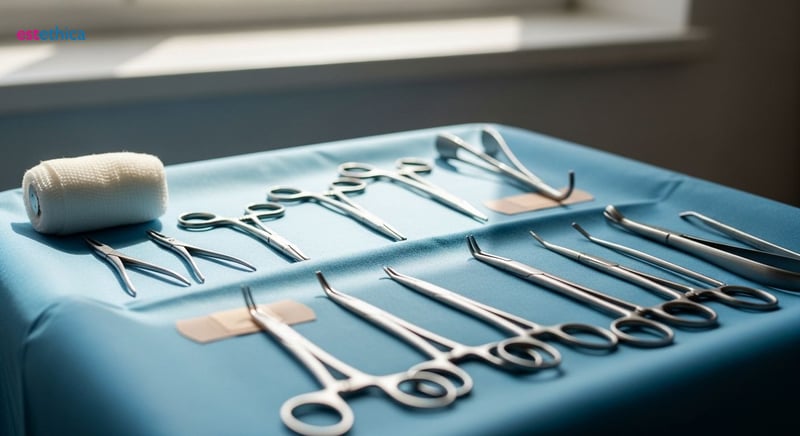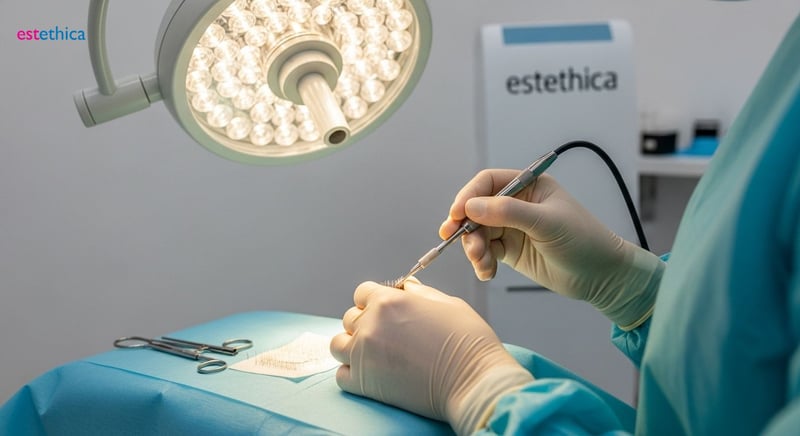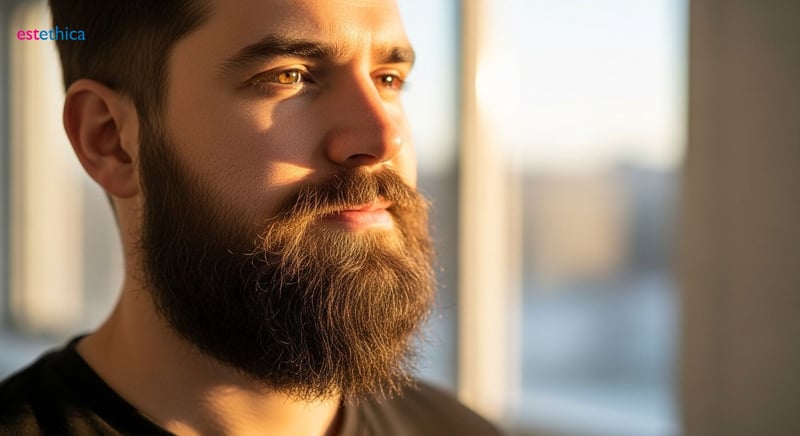Unlock Your Facial Hair Potential: The Ultimate Beard Transplant Guide
Explore transformative beard transplant solutions and unlock your full facial hair potential today.
Unlocking the potential of your beard can significantly enhance personal style, confidence, and overall aesthetics. The rise in popularity of beard transplants offers individuals with patchy or thin facial hair the opportunity to achieve the beard of their dreams. This guide explores various aspects of beard transplants, from selecting the right design to understanding the procedure's longevity and results. Discover how you can transform your facial appearance with innovative hair transplant techniques.
Beard Implants: Crafting Your Ideal Facial Hair Design
Designing a Bespoke Beard for Your Unique Face
Your facial hair presents a canvas as distinct as your personality. Accordingly, the concept of a universal approach to beard transplant proves to be inherently flawed. For example, designing your ideal beard necessitates a careful assessment of your facial structure, an understanding of your personal style inclinations, and explicit articulation of your aesthetic aspirations.
Beard implants, therefore, can be customized meticulously to align with your vision, whether you aspire towards a robust, outdoorsy appearance or a refined, contemporary image. Beginning with a comprehensive consultation, specialists thoroughly evaluate your preferences, scrutinize your facial anatomy, and formulate a personalized strategy guaranteeing aesthetically pleasing and naturally appearing results.
Techniques Used in Beard Implants
- Follicular Unit Extraction (FUE): FUE is the most popular method, involving extracting individual hair follicles from the donor area (typically the back of the scalp) and transplanting them to the beard area. This technique minimizes scarring.
- Direct Hair Implantation (DHI): A refined version of FUE, DHI uses a specialized pen-like tool to implant the hair follicles directly into the skin, allowing for greater precision and control over the angle and depth of implantation.
- Follicular Unit Transplantation (FUT): Also known as strip harvesting, FUT involves removing a strip of skin from the donor area, then dissecting it into individual follicular units for transplantation. While effective, it leaves a linear scar.
Stages of Designing the Ideal Beard
- Initial Consultation and Assessment: During the initial visit, the surgeon assesses the patient's facial structure, discusses desired beard style, and evaluates the donor area for hair availability and quality. They also discuss the beard transplant cost.
- Design and Planning: A detailed beard design is crafted to complement the patient's face shape and personal preferences. The surgeon determines the number of grafts needed and maps out the placement of each follicle.
- Implantation: Using the selected technique (FUE, DHI, or FUT), hair follicles are carefully implanted into the beard area, following the predetermined design. Attention is given to angle, depth, and density to mimic natural beard growth.

Follicular Unit Extraction Beard: The Science Behind Natural Results
Understanding the Precision of FUE
Follicular Unit Extraction (FUE) stands at the forefront of advanced hair transplantation techniques, particularly celebrated for delivering results that possess a remarkable natural aesthetic. This minimally invasive method is predicated on the meticulous individual extraction of hair follicles from a designated donor site—typically located at the back of the scalp—followed by their strategic implantation into the beard region. One of the cardinal advantages of FUE lies in its unparalleled precision; each follicle is transferred without necessitating a linear incision, thereby significantly diminishing visible scarring and expediting the recovery process.
The strategic allocation of these follicles is designed to mirror the inherent hair growth patterns, ensuring an immaculate assimilation with your existing facial hair. Furthermore, FUE demonstrates impressive versatility, adeptly addressing patchy areas or undertaking the comprehensive reconstruction of an entirely novel beard configuration.
Key Benefits of FUE Beard Transplants
- Minimal Scarring: Unlike traditional strip methods, FUE leaves tiny, almost invisible scars, allowing for shorter hairstyles without revealing the transplant.
- Natural Look: The strategic placement of individual follicles mimics natural hair growth, ensuring the transplanted beard blends seamlessly with existing facial hair.
- Faster Recovery: The minimally invasive nature of FUE translates to reduced recovery times, allowing patients to return to their normal routines sooner.
The FUE Transplantation Process
- Extraction: Individual hair follicles are carefully extracted from the donor area using a specialized micro-punch tool.
- Preparation: The extracted follicles are prepared under a microscope to ensure their viability and readiness for transplantation.
- Implantation: The prepared follicles are meticulously implanted into the beard area, following a pre-determined design that aligns with natural hair growth patterns.

Beard Transplant Before and After: Witnessing the Transformation
Visual Proof: The Impact of Beard Implants
The dramatic change a beard transplant can achieve is often best seen through beard transplant before and after photos. These images demonstrate the procedure's effectiveness, showcasing the significant improvements possible. Clients with patchy or thin facial hair often gain noticeable confidence after the procedure. The before-and-after images not only reveal increased density but also illustrate the natural look achieved through expert implantation. For individuals considering a beard transplant, these results illustrate the potential improvements and inspire confidence in moving forward with beard enhancement.
For example, consider a client who had minimal facial hair due to genetic factors. Before the transplant, their face appeared youthful, but they felt it lacked definition. Post-transplant, the added beard not only provided definition but also enhanced their masculine features, leading to a significant boost in self-esteem. Or another client might have had scarring from an accident, leaving them with a patchy beard. The transplant filled in these gaps, creating a smooth, consistent beard line that restored their confidence.
How to Assess Beard Transplant Results
- Density and Fullness: Examine how the density of the beard has improved post-transplant. A successful transplant should result in a fuller, thicker beard that effectively covers previously sparse areas.
- Natural Look: Evaluate how naturally the transplanted hair blends with the existing facial hair. The implanted hair should match the color, texture, and growth pattern of the original beard.
- Contour and Shape: Assess the overall shape and contour of the beard. A well-designed beard transplant should complement the client's facial features, enhancing their overall appearance with a defined and aesthetically pleasing shape.
Factors Influencing Beard Transplant Outcomes
- Technique and Skill of the Surgeon: The surgeon's expertise plays a critical role in determining the success and natural look of the transplant. Skilled surgeons ensure proper follicle placement and angle to mimic natural growth.
- Quality of Donor Hair: The health and density of the donor hair significantly impact the outcome. Strong, healthy follicles are more likely to thrive after transplantation, leading to better density and coverage.
- Patient's Aftercare Compliance: Following post-operative instructions is crucial for optimal healing and hair growth. Proper care ensures the transplanted follicles integrate well and achieve the desired density.

Is a Beard Transplant Permanent? Longevity and Maintenance Explored
Maximizing the Lifespan of Your Beard Implants
One of the critical questions potential clients ask is about the permanence of beard transplants. Generally speaking, a beard transplant is a lasting solution. Once transplanted, the hair continues to grow naturally as part of your facial hair. However, proper post-operative care is crucial in ensuring the longevity of your results. Regular trimming, cleaning, and moisturizing not only maintain the health of the hair but also support its natural growth cycle. Periodic consultations with your transplant specialist can also help address any concerns and keep your beard looking its best. While the initial post-surgery phase may require some adjustment, the long-term results provide a robust solution to previous facial hair concerns.
Essential Steps for Long-Term Beard Maintenance
- Regular Cleansing: Washing your transplanted beard with a mild, sulfate-free shampoo helps remove dirt and oils, preventing infections and promoting healthy hair growth.
- Consistent Hydration: Applying a beard oil or balm keeps the hair moisturized, preventing dryness and breakage. Hydrated hair is less prone to damage and maintains its natural sheen.
- Careful Trimming: Regular trimming maintains the desired shape and length of the beard. It also removes split ends, preventing them from traveling up the hair shaft and causing further damage.
Factors Affecting the Durability of Beard Transplants
- Quality of Initial Procedure: The skill and experience of the surgical team significantly influence the success and longevity of the transplant. Precise follicle placement and adherence to best practices are critical.
- Individual Hair Characteristics: The quality and characteristics of the donor hair, such as thickness and growth rate, can affect how well the transplanted beard thrives over time.
- Overall Health and Lifestyle: A healthy lifestyle, including a balanced diet, regular exercise, and avoiding smoking, supports optimal hair growth and improves the durability of the beard implants.
Ultimate Guide to Beard Transplant: Transform Your Look
Precision FUE and DHI Beard Transplants for Naturally Aesthetic Facial Hair Restoration
estethica specializes in Follicular Unit Extraction (FUE) and Direct Hair Implantation (DHI) for beard transplants, ensuring minimal scarring and natural-looking results. These techniques involve meticulous individual extraction and precise implantation to perfectly mimic natural hair growth patterns.
estethica's skilled surgeons meticulously design bespoke beard shapes tailored to individual facial structures and aesthetic preferences during initial consultation. The clinic provides comprehensive assessments and personalized strategies, ensuring aesthetically pleasing and natural-appearing results for each patient.
Personalized Beard Transplant Processes for Enhanced Patient Satisfaction and Long-Term Results
estethica prioritizes patient-centered care throughout the beard transplant process, from the initial consultation and personalized design to the meticulous implantation and comprehensive aftercare, ensuring results that last. Continuous support and expert advice optimize hair health and sustain natural growth cycles, fostering patient confidence.
Clients who underwent beard transplants at estethica have reported enhanced facial definition and increased self-esteem following successful FUE and DHI procedures. The clinic is dedicated to restoring confidence and ensuring a natural aesthetic through personalized transplant solutions.
Frequently Asked Questions
What is a follicular unit extraction beard transplant and why is it preferred for facial hair restoration?
How long does a beard transplant last, and what is needed for long-term maintenance of beard implants?
What should I expect from beard transplant before and after photos, and how can I assess the results?
How is the ideal facial hair design crafted during beard implants, and what factors are considered?
Ready to experience world-class aesthetics and healthcare tailored to your needs?
📞 Call Now for Your Free Consultation!